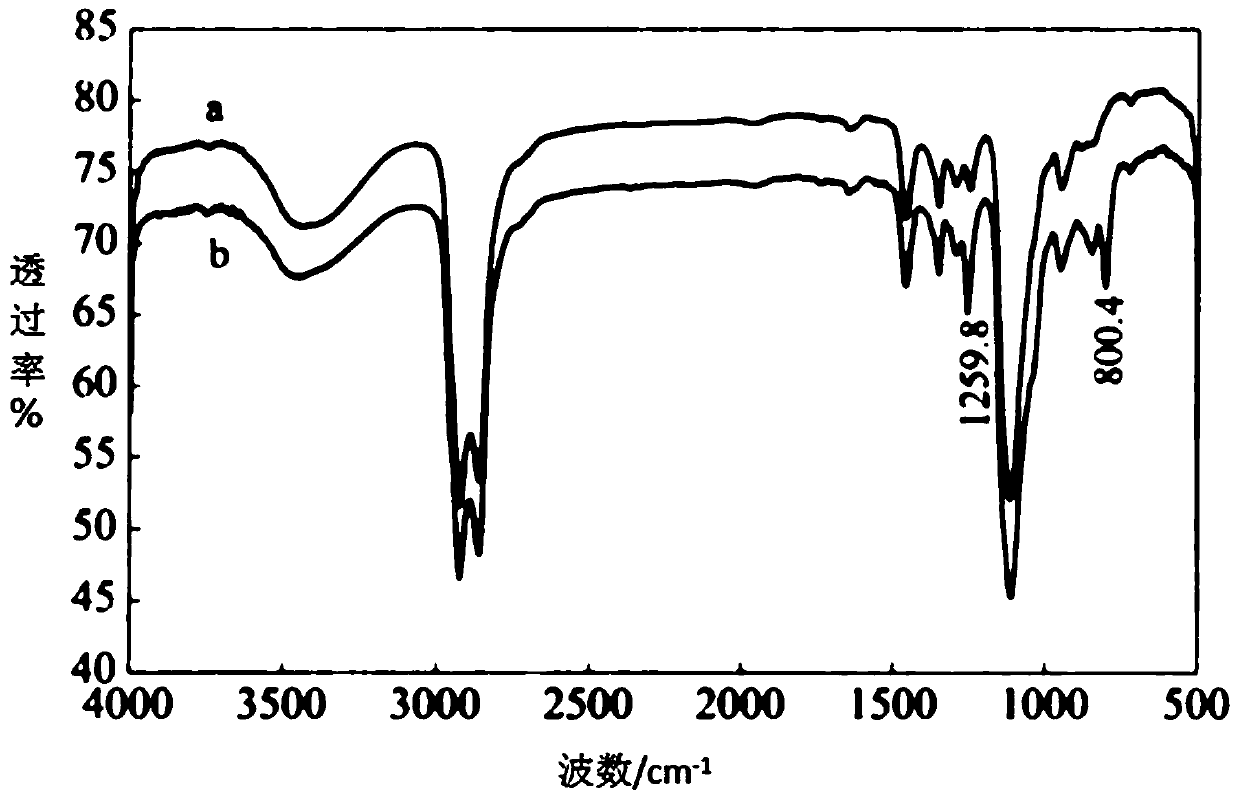A kind of silicon-modified polyether and preparation method thereof, application
A silicon modification, polyether technology, applied in the direction of silicon organic compounds, non-ionic surface active compounds, fiber treatment, etc., can solve the problems of high price of silicone defoamer and affecting the quality of textiles
- Summary
- Abstract
- Description
- Claims
- Application Information
AI Technical Summary
Problems solved by technology
Method used
Image
Examples
Embodiment 1
[0056] 1. Preparation of polyether:
[0057] In the pressure reactor, add 100 parts of isooctyl alcohol (6-methyl-1-heptanol) and KOH (the amount is 0.2% of the weight of isooctyl alcohol), replace the air in the kettle with nitrogen for 3 times, and heat up to 110 ℃, dehydration for 30min in a vacuum environment below -0.09MPa. Then the temperature was raised to 120°C, and ethylene oxide was slowly added dropwise (the molar ratio of ethylene oxide to isooctyl alcohol was 3:1), and the ring-opening polymerization was carried out at a pressure of 0.25 MPa and a temperature of 130°C. After the ethylene oxide is finished, the aging reaction is 30 minutes, and the polyether is obtained; its general structural formula is as follows:
[0058]
[0059] Wherein, R-O- is the dehydrogenated part of 6-methyl-1-heptanol, m=3, n=0;
[0060] Measure the hydroxyl value [I(OH)(mg / g)] of the synthesized polyether according to the method of GB / T 7383-2007, and use the formula (1): (56.1×10...
Embodiment 2
[0069]1. Preparation of polyether:
[0070] In the pressure reactor, add 100 parts of isooctyl alcohol (EXXAL TM 8) and NaOH (the amount of which is 0.15% of the weight of isooctyl alcohol), replace the air in the kettle with nitrogen for 3 times, heat up to 110°C, and dehydrate for 30min under a vacuum environment below -0.09MPa. Then the temperature was raised to 120°C, and ethylene oxide was slowly added dropwise (the molar ratio of ethylene oxide to isooctyl alcohol was 5:1), and the ring-opening polymerization was carried out at a pressure of 0.2 MPa and a temperature of 135°C. After the ethylene oxide is finished, the aging reaction is 30 minutes, and the polyether is obtained; its general structural formula is as follows:
[0071]
[0072] Among them, R-O- is isooctyl alcohol (EXXAL TM 8) The part dehydrogenated, m=5, n=0.
[0073] Measure the hydroxyl value [I(OH)(mg / g)] of the synthesized polyether according to the method of GB / T 7383-2007, and use the formula (...
Embodiment 3
[0082] 1. Preparation of polyether:
[0083] In a pressure reactor, add 100 parts of isooctyl alcohol (6-methyl-1-heptanol) and NaOCH 3 (The consumption is 0.25% of the weight of isooctyl alcohol), replace the air in the kettle with nitrogen for 3 times, heat up to 110° C., and dehydrate for 30 minutes under a vacuum environment below −0.09 MPa. Then the temperature was raised to 120°C, and ethylene oxide was slowly added dropwise (the molar ratio of ethylene oxide to isooctyl alcohol was 10:1), and the ring-opening polymerization was carried out at a pressure of 0.3 MPa and a temperature of 135°C. After the ethylene oxide is finished, the aging reaction is 30min; slowly add propylene oxide (the molar ratio of propylene oxide to isooctyl alcohol is 2:1), and carry out the ring-opening polymerization reaction at a pressure of 0.3MPa and a temperature of 135°C After the dropwise addition of propylene oxide, the aging reaction was performed for 30 minutes to obtain the polyether...
PUM
 Login to View More
Login to View More Abstract
Description
Claims
Application Information
 Login to View More
Login to View More - R&D
- Intellectual Property
- Life Sciences
- Materials
- Tech Scout
- Unparalleled Data Quality
- Higher Quality Content
- 60% Fewer Hallucinations
Browse by: Latest US Patents, China's latest patents, Technical Efficacy Thesaurus, Application Domain, Technology Topic, Popular Technical Reports.
© 2025 PatSnap. All rights reserved.Legal|Privacy policy|Modern Slavery Act Transparency Statement|Sitemap|About US| Contact US: help@patsnap.com



